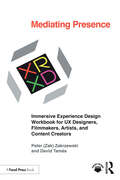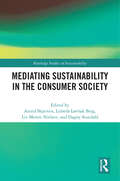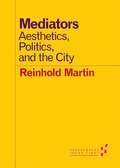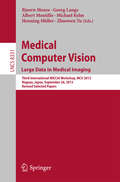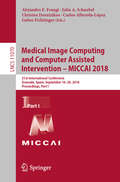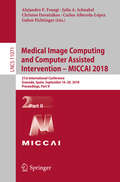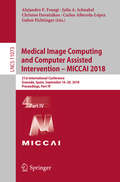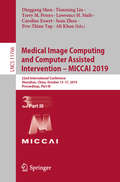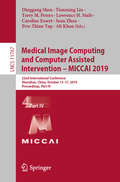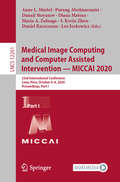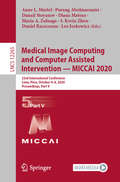- Table View
- List View
Mediating Netherlandish Art and Material Culture in Asia (Amsterdam Studies in the Dutch Golden Age)
by Michael North Thomas DaCosta KaufmannWhile the socio-economic and historical aspects of the Dutch East India Company (VOC) have been extensively documented and researched, the role of the VOC in visual culture and the arts has been relatively neglected. This authoritative volume addresses various aspects of cultural exchange between the Low Countries and Asia. Increased prosperity and the flood of imported goods from Asia had a huge influence on seventeenth-century Holland. To cite some examples: when the VOC spread its merchandise throughout the various regions of Asia, Chinese decorative motives became popular in Indonesia. After the lifting of the seventeenth-century ban on the import of Christian books to Japan, a wave of interest in Dutch culture hit the country, giving rise to Hollandmania, imitation of anything Dutch. Mediating Netherlandish Art and Material Culture in Asia offers new insights into the world routes travelled by seventeenth-century Dutch visual culture, as well as the rise of Asian influence in the imagery of the Dutch Golden Age.
Mediating Presence: Immersive Experience Design Workbook for UX Designers, Filmmakers, Artists, and Content Creators
by Peter Zakrzewski David TamésMediating Presence: Immersive Experience Design Workbook for UX Designers, Filmmakers, Artists, and Content Creators provides the foundation for a broader understanding of the impact of XR as the next medium. The methods presented draw from a wide range of disciplines and professional practice to provide a practical guide to design methods, production techniques, best practices, and terminology that provides an effective road map for developing immersive experiences using augmented reality, virtual reality, augmented virtuality, and other emerging immersive media forms.In this book, media designers Peter (Zak) Zakrzewski and David Tamés present a comprehensive framework for XR media experience design (XRXD) that will allow UX designers, filmmakers, artists, and content creators to connect their audiences to rich, multimodal, immersive experiences for entertainment, learning, creating, and healing. This book guides the reader through a 12+1-step design-based model for creating XR experiences. Each step is accompanied by specific media design methods expressly created for or adapted to XR content creation. The theoretical concepts and methods covered address the specific context and meaning aspects of the XR media environments being created.
Mediating Sustainability in the Consumer Society (Routledge Studies in Sustainability)
by Dagny Stuedahl Astrid Skjerven Lisbeth Løvbak Berg Liv Merete NielsenThis book sheds light on the role and impact of sustainability mediation, an effective tool for political authorities and business enterprises to persuade consumers of the integrity of their actions, products, and services.In this era of ecological and societal crises fuelled by increasing consumption, sustainability has become a key buzzword and target to attain. Governments around the world argue that they will meet their sustainability goals through environmental actions, by enabling consumers to make better choices and expecting brands to respond accordingly. At the same time, consumers are overwhelmed by the messaging conveyed in sustainability marketing campaigns, often featuring misleading greenwashing, with political authorities, organisations, and business enterprises all having conflicting interests. In this complex scenario, mediation has become a crucial issue. This book offers a critical and multidisciplinary view of sustainability mediation from experts in the fields of philosophy, consumption research, media studies, fashion, design, and citizenship, offering a unique, holistic view. Each chapter highlights different and problematic aspects of the cultural narratives being communicated, for example, the necessity of growth and the notion of a green economy. They present current theories, methods, indicators, and strategies used to assess and measure the relation between mediation, behaviour, and sustainable development.This book is of interest to scholars, researchers, and postgraduate students in all subject fields concerned with sustainability, including design, visual communication, fashion, consumption, media and journalism, and sustainable development.
Mediating the Uprising: Narratives of Gender and Marriage in Syrian Television Drama (Politics of Marriage and Gender: Global Issues in Local Contexts)
by Rebecca JoubinMediating the Uprising: Narratives of Gender and Marriage in Syrian Television Drama shows how gender and marriage metaphors inform post-uprising Syrian drama for various forms of cultural and political critique. These narratives have become complicated since the uprising due to the Syrian regime’s effort to control the revolutionary discourse. As Syria’s uprising spawned more terrorist groups, some drama creators became nostalgic for pre-war days. While for some screenwriters a return to pre-2011 life would be welcome after so much bloodshed, others advocated profound cultural and social transformation, instead. They employed marriage and gender metaphors in the stories they wrote to engage in political critique, even at the risk of creating marketing difficulties for the shows or they created escapist stories such as transnational adaptations and Old Damascus tales. Serving as heritage preservation, Mediating the Uprising underscores that television drama creators in Syria have many ways of engaging in protest, with gender and marriage at the heart of the polemic.
Mediations of Disruption in Post-Conflict Cinema
by Adriana Martins Alexandra Lopes Mónica DiasMediations of Disruption in Post-Conflict Cinema is a transdisciplinary volume that addresses the cinematic mediation of a wide range of conflicts. From World War II and its aftermath to the exploration of colonial and post-colonial experiences and more recent forms of terrorism, it debates the possibilities, constraints and efficacy of the discursive practices this mediation entails. Despite its variety and amplitude in scope and width, the innovative and singular aspect of the book lies in the fact that the essays give voice to a variety of regions, issues, and filmmaking processes that tend either to remain on the outskirts of the publishing world and/or to be granted only partial visibility in volumes of regional cinema.
Mediators: Aesthetics, Politics, and the City (Forerunners: Ideas First)
by Reinhold MartinReinhold Martin&’s Mediators is a series of linked meditations on the globalized city. Focusing on infrastructural, technical, and social systems, Martin explores how the aesthetics and the political economy of cities overlap and interact. He discusses a range of subjects, including the architecture of finance written into urban policy, regimes of enumeration that remix city and country, fictional ecologies that rewrite biopolitics, the ruins of socialism strewn amid the transnational commons, and memories of revolution stored in everyday urban hardware. For Martin, these mediators—the objects, processes, and imaginaries from which these phenomena emerge—serve to explain disparate fragments of a global urbanity.Forerunners: Ideas First is a thought-in-process series of breakthrough digital publications. Written between fresh ideas and finished books, Forerunners draws on scholarly work initiated in notable blogs, social media, conference plenaries, journal articles, and the synergy of academic exchange. This is gray literature publishing: where intense thinking, change, and speculation take place in scholarship.
Medical Computer Vision. Large Data in Medical Imaging: Third International MICCAI Workshop, MCV 2013, Nagoya, Japan, September 26, 2013, Revised Selected Papers (Lecture Notes in Computer Science #8331)
by Bjoern Menze, Georg Langs, Albert Montillo, Michael Kelm, Henning Müller and Zhuowen TuThis book constitutes the thoroughly refereed post-workshop proceedings of the Third International Workshop on Medical Computer Vision, MCV 2013, held in Nagoya, Japan, in September 2013 in conjunction with the 16th International Conference on Medical Image Computing and Computer-Assisted Intervention, MICCAI 2013. The 7 revised full papers and 12 poster papers presented were selected from 25 submissions. They have been organized in topical sections on registration and visualization, segmentation, detection and localization, and features and retrieval. In addition, the volume contains two invited papers describing segmentation task and data set of the VISCERAL benchmark challenge.
Medical Illustration in the Courtroom: Proving Injury, Causation, and Damages
by Lindsay E. CoulterMedical Illustration in the Courtroom: Proving Injury, Causation, and Damages educates the reader on how to communicate science visually—in personal injury, medical malpractice, criminal, and forensic cases—by creating art that utilizes medical records, radiographs, and computer software. Medical illustration bridges the gap between complex technical, medical, and scientific concepts to clearly illustrate, and explain visually, a medical condition, negligence, or the causation of an injury or death to the lay person. Medical artists are frequently challenged with illustrating injuries and medical conditions that can’t be seen by the naked eye. And while using medical photography and imaging for illustrative purposes can be helpful, to an untrained eye it can often be unclear or confusing. This is where the medical illustrator enters the equation. There are often patients who have recovered from an injury or infection that appear in good health. However, should an unforeseen injury or fatality happen, medical illustrators can reveal to people what’s actually going on inside the person, an invaluable asset to attorneys in the courtroom—especially for personal injury and medical malpractice cases. While many attorneys utilize medical artists, nonvisual people don’t always recognize the value of demonstrative aids until they see them first-hand.When attorneys and their clients enlist the aid of medical artists, it quickly becomes apparent that properly conceived and executed artwork is invaluable to illustrating the facts—and medical impacts—of any number of scenarios: homicides by shooting, stabbings, vehicular accidents, in addition to medical malpractice and personal injuries resulting from surgery or possible negligence.Presenting a myriad of services and computer technologies that can be utilized, Medical Illustration in the Courtroom provides demonstrative aids used in cases to illustrate personal injury and medical malpractice, employing "tricks of the trade" to create an accurate effective image. Such images are educational to attorneys, insurance adjusters, judges, and juries to help create a visual storyline, the goal being to help combine art and science to provide a clear illustration of events to help in adjudicate legal and forensic cases.
Medical Image Computing and Computer Assisted Intervention – MICCAI 2018: 21st International Conference, Granada, Spain, September 16-20, 2018, Proceedings, Part I (Lecture Notes in Computer Science #11070)
by Alejandro F. Frangi Gabor Fichtinger Julia A. Schnabel Christos Davatzikos Carlos Alberola-LópezThe four-volume set LNCS 11070, 11071, 11072, and 11073 constitutes the refereed proceedings of the 21st International Conference on Medical Image Computing and Computer-Assisted Intervention, MICCAI 2018, held in Granada, Spain, in September 2018. The 373 revised full papers presented were carefully reviewed and selected from 1068 submissions in a double-blind review process. The papers have been organized in the following topical sections: Part I: Image Quality and Artefacts; Image Reconstruction Methods; Machine Learning in Medical Imaging; Statistical Analysis for Medical Imaging; Image Registration Methods. Part II: Optical and Histology Applications: Optical Imaging Applications; Histology Applications; Microscopy Applications; Optical Coherence Tomography and Other Optical Imaging Applications. Cardiac, Chest and Abdominal Applications: Cardiac Imaging Applications: Colorectal, Kidney and Liver Imaging Applications; Lung Imaging Applications; Breast Imaging Applications; Other Abdominal Applications. Part III: Diffusion Tensor Imaging and Functional MRI: Diffusion Tensor Imaging; Diffusion Weighted Imaging; Functional MRI; Human Connectome. Neuroimaging and Brain Segmentation Methods: Neuroimaging; Brain Segmentation Methods.Part IV: Computer Assisted Intervention: Image Guided Interventions and Surgery; Surgical Planning, Simulation and Work Flow Analysis; Visualization and Augmented Reality. Image Segmentation Methods: General Image Segmentation Methods, Measures and Applications; Multi-Organ Segmentation; Abdominal Segmentation Methods; Cardiac Segmentation Methods; Chest, Lung and Spine Segmentation; Other Segmentation Applications.
Medical Image Computing and Computer Assisted Intervention – MICCAI 2018: 21st International Conference, Granada, Spain, September 16-20, 2018, Proceedings, Part II (Lecture Notes in Computer Science #11071)
by Alejandro F. Frangi Gabor Fichtinger Julia A. Schnabel Christos Davatzikos Carlos Alberola-LópezThe four-volume set LNCS 11070, 11071, 11072, and 11073 constitutes the refereed proceedings of the 21st International Conference on Medical Image Computing and Computer-Assisted Intervention, MICCAI 2018, held in Granada, Spain, in September 2018. The 373 revised full papers presented were carefully reviewed and selected from 1068 submissions in a double-blind review process. The papers have been organized in the following topical sections: Part I: Image Quality and Artefacts; Image Reconstruction Methods; Machine Learning in Medical Imaging; Statistical Analysis for Medical Imaging; Image Registration Methods. Part II: Optical and Histology Applications: Optical Imaging Applications; Histology Applications; Microscopy Applications; Optical Coherence Tomography and Other Optical Imaging Applications. Cardiac, Chest and Abdominal Applications: Cardiac Imaging Applications: Colorectal, Kidney and Liver Imaging Applications; Lung Imaging Applications; Breast Imaging Applications; Other Abdominal Applications. Part III: Diffusion Tensor Imaging and Functional MRI: Diffusion Tensor Imaging; Diffusion Weighted Imaging; Functional MRI; Human Connectome. Neuroimaging and Brain Segmentation Methods: Neuroimaging; Brain Segmentation Methods.Part IV: Computer Assisted Intervention: Image Guided Interventions and Surgery; Surgical Planning, Simulation and Work Flow Analysis; Visualization and Augmented Reality. Image Segmentation Methods: General Image Segmentation Methods, Measures and Applications; Multi-Organ Segmentation; Abdominal Segmentation Methods; Cardiac Segmentation Methods; Chest, Lung and Spine Segmentation; Other Segmentation Applications.
Medical Image Computing and Computer Assisted Intervention – MICCAI 2018: 21st International Conference, Granada, Spain, September 16-20, 2018, Proceedings, Part III (Lecture Notes in Computer Science #11072)
by Alejandro F. Frangi Gabor Fichtinger Julia A. Schnabel Christos Davatzikos Carlos Alberola-LópezThe four-volume set LNCS 11070, 11071, 11072, and 11073 constitutes the refereed proceedings of the 21st International Conference on Medical Image Computing and Computer-Assisted Intervention, MICCAI 2018, held in Granada, Spain, in September 2018. The 373 revised full papers presented were carefully reviewed and selected from 1068 submissions in a double-blind review process. The papers have been organized in the following topical sections: Part I: Image Quality and Artefacts; Image Reconstruction Methods; Machine Learning in Medical Imaging; Statistical Analysis for Medical Imaging; Image Registration Methods. Part II: Optical and Histology Applications: Optical Imaging Applications; Histology Applications; Microscopy Applications; Optical Coherence Tomography and Other Optical Imaging Applications. Cardiac, Chest and Abdominal Applications: Cardiac Imaging Applications: Colorectal, Kidney and Liver Imaging Applications; Lung Imaging Applications; Breast Imaging Applications; Other Abdominal Applications. Part III: Diffusion Tensor Imaging and Functional MRI: Diffusion Tensor Imaging; Diffusion Weighted Imaging; Functional MRI; Human Connectome. Neuroimaging and Brain Segmentation Methods: Neuroimaging; Brain Segmentation Methods.Part IV: Computer Assisted Intervention: Image Guided Interventions and Surgery; Surgical Planning, Simulation and Work Flow Analysis; Visualization and Augmented Reality. Image Segmentation Methods: General Image Segmentation Methods, Measures and Applications; Multi-Organ Segmentation; Abdominal Segmentation Methods; Cardiac Segmentation Methods; Chest, Lung and Spine Segmentation; Other Segmentation Applications.
Medical Image Computing and Computer Assisted Intervention – MICCAI 2018: 21st International Conference, Granada, Spain, September 16-20, 2018, Proceedings, Part IV (Lecture Notes in Computer Science #11073)
by Alejandro F. Frangi Gabor Fichtinger Julia A. Schnabel Christos Davatzikos Carlos Alberola-LópezThe four-volume set LNCS 11070, 11071, 11072, and 11073 constitutes the refereed proceedings of the 21st International Conference on Medical Image Computing and Computer-Assisted Intervention, MICCAI 2018, held in Granada, Spain, in September 2018. The 373 revised full papers presented were carefully reviewed and selected from 1068 submissions in a double-blind review process. The papers have been organized in the following topical sections: Part I: Image Quality and Artefacts; Image Reconstruction Methods; Machine Learning in Medical Imaging; Statistical Analysis for Medical Imaging; Image Registration Methods. Part II: Optical and Histology Applications: Optical Imaging Applications; Histology Applications; Microscopy Applications; Optical Coherence Tomography and Other Optical Imaging Applications. Cardiac, Chest and Abdominal Applications: Cardiac Imaging Applications: Colorectal, Kidney and Liver Imaging Applications; Lung Imaging Applications; Breast Imaging Applications; Other Abdominal Applications. Part III: Diffusion Tensor Imaging and Functional MRI: Diffusion Tensor Imaging; Diffusion Weighted Imaging; Functional MRI; Human Connectome. Neuroimaging and Brain Segmentation Methods: Neuroimaging; Brain Segmentation Methods.Part IV: Computer Assisted Intervention: Image Guided Interventions and Surgery; Surgical Planning, Simulation and Work Flow Analysis; Visualization and Augmented Reality. Image Segmentation Methods: General Image Segmentation Methods, Measures and Applications; Multi-Organ Segmentation; Abdominal Segmentation Methods; Cardiac Segmentation Methods; Chest, Lung and Spine Segmentation; Other Segmentation Applications.
Medical Image Computing and Computer Assisted Intervention – MICCAI 2019: 22nd International Conference, Shenzhen, China, October 13–17, 2019, Proceedings, Part I (Lecture Notes in Computer Science #11764)
by Ali Khan Pew-Thian Yap Dinggang Shen Terry M. Peters Tianming Liu Lawrence H. Staib Caroline Essert Sean ZhouThe six-volume set LNCS 11764, 11765, 11766, 11767, 11768, and 11769 constitutes the refereed proceedings of the 22nd International Conference on Medical Image Computing and Computer-Assisted Intervention, MICCAI 2019, held in Shenzhen, China, in October 2019. The 539 revised full papers presented were carefully reviewed and selected from 1730 submissions in a double-blind review process. The papers are organized in the following topical sections: Part I: optical imaging; endoscopy; microscopy. Part II: image segmentation; image registration; cardiovascular imaging; growth, development, atrophy and progression. Part III: neuroimage reconstruction and synthesis; neuroimage segmentation; diffusion weighted magnetic resonance imaging; functional neuroimaging (fMRI); miscellaneous neuroimaging. Part IV: shape; prediction; detection and localization; machine learning; computer-aided diagnosis; image reconstruction and synthesis. Part V: computer assisted interventions; MIC meets CAI. Part VI: computed tomography; X-ray imaging.
Medical Image Computing and Computer Assisted Intervention – MICCAI 2019: 22nd International Conference, Shenzhen, China, October 13–17, 2019, Proceedings, Part II (Lecture Notes in Computer Science #11765)
by Ali Khan Pew-Thian Yap Dinggang Shen Terry M. Peters Tianming Liu Lawrence H. Staib Caroline Essert Sean ZhouThe six-volume set LNCS 11764, 11765, 11766, 11767, 11768, and 11769 constitutes the refereed proceedings of the 22nd International Conference on Medical Image Computing and Computer-Assisted Intervention, MICCAI 2019, held in Shenzhen, China, in October 2019. The 539 revised full papers presented were carefully reviewed and selected from 1730 submissions in a double-blind review process. The papers are organized in the following topical sections: Part I: optical imaging; endoscopy; microscopy. Part II: image segmentation; image registration; cardiovascular imaging; growth, development, atrophy and progression. Part III: neuroimage reconstruction and synthesis; neuroimage segmentation; diffusion weighted magnetic resonance imaging; functional neuroimaging (fMRI); miscellaneous neuroimaging. Part IV: shape; prediction; detection and localization; machine learning; computer-aided diagnosis; image reconstruction and synthesis. Part V: computer assisted interventions; MIC meets CAI. Part VI: computed tomography; X-ray imaging.
Medical Image Computing and Computer Assisted Intervention – MICCAI 2019: 22nd International Conference, Shenzhen, China, October 13–17, 2019, Proceedings, Part III (Lecture Notes in Computer Science #11766)
by Ali Khan Pew-Thian Yap Dinggang Shen Terry M. Peters Tianming Liu Lawrence H. Staib Caroline Essert Sean ZhouThe six-volume set LNCS 11764, 11765, 11766, 11767, 11768, and 11769 constitutes the refereed proceedings of the 22nd International Conference on Medical Image Computing and Computer-Assisted Intervention, MICCAI 2019, held in Shenzhen, China, in October 2019. The 539 revised full papers presented were carefully reviewed and selected from 1730 submissions in a double-blind review process. The papers are organized in the following topical sections: Part I: optical imaging; endoscopy; microscopy. Part II: image segmentation; image registration; cardiovascular imaging; growth, development, atrophy and progression. Part III: neuroimage reconstruction and synthesis; neuroimage segmentation; diffusion weighted magnetic resonance imaging; functional neuroimaging (fMRI); miscellaneous neuroimaging. Part IV: shape; prediction; detection and localization; machine learning; computer-aided diagnosis; image reconstruction and synthesis. Part V: computer assisted interventions; MIC meets CAI. Part VI: computed tomography; X-ray imaging.
Medical Image Computing and Computer Assisted Intervention – MICCAI 2019: 22nd International Conference, Shenzhen, China, October 13–17, 2019, Proceedings, Part IV (Lecture Notes in Computer Science #11767)
by Ali Khan Pew-Thian Yap Dinggang Shen Terry M. Peters Tianming Liu Lawrence H. Staib Caroline Essert Sean ZhouThe six-volume set LNCS 11764, 11765, 11766, 11767, 11768, and 11769 constitutes the refereed proceedings of the 22nd International Conference on Medical Image Computing and Computer-Assisted Intervention, MICCAI 2019, held in Shenzhen, China, in October 2019. The 539 revised full papers presented were carefully reviewed and selected from 1730 submissions in a double-blind review process. The papers are organized in the following topical sections: Part I: optical imaging; endoscopy; microscopy. Part II: image segmentation; image registration; cardiovascular imaging; growth, development, atrophy and progression. Part III: neuroimage reconstruction and synthesis; neuroimage segmentation; diffusion weighted magnetic resonance imaging; functional neuroimaging (fMRI); miscellaneous neuroimaging. Part IV: shape; prediction; detection and localization; machine learning; computer-aided diagnosis; image reconstruction and synthesis. Part V: computer assisted interventions; MIC meets CAI. Part VI: computed tomography; X-ray imaging.
Medical Image Computing and Computer Assisted Intervention – MICCAI 2019: 22nd International Conference, Shenzhen, China, October 13–17, 2019, Proceedings, Part V (Lecture Notes in Computer Science #11768)
by Ali Khan Pew-Thian Yap Dinggang Shen Terry M. Peters Tianming Liu Lawrence H. Staib Caroline Essert Sean ZhouThe six-volume set LNCS 11764, 11765, 11766, 11767, 11768, and 11769 constitutes the refereed proceedings of the 22nd International Conference on Medical Image Computing and Computer-Assisted Intervention, MICCAI 2019, held in Shenzhen, China, in October 2019. The 539 revised full papers presented were carefully reviewed and selected from 1730 submissions in a double-blind review process. The papers are organized in the following topical sections: Part I: optical imaging; endoscopy; microscopy.Part II: image segmentation; image registration; cardiovascular imaging; growth, development, atrophy and progression.Part III: neuroimage reconstruction and synthesis; neuroimage segmentation; diffusion weighted magnetic resonance imaging; functional neuroimaging (fMRI); miscellaneous neuroimaging.Part IV: shape; prediction; detection and localization; machine learning; computer-aided diagnosis; image reconstruction and synthesis.Part V: computer assisted interventions; MIC meets CAI. Part VI: computed tomography; X-ray imaging.
Medical Image Computing and Computer Assisted Intervention – MICCAI 2019: 22nd International Conference, Shenzhen, China, October 13–17, 2019, Proceedings, Part VI (Lecture Notes in Computer Science #11769)
by Ali Khan Pew-Thian Yap Dinggang Shen Terry M. Peters Tianming Liu Lawrence H. Staib Caroline Essert Sean ZhouThe six-volume set LNCS 11764, 11765, 11766, 11767, 11768, and 11769 constitutes the refereed proceedings of the 22nd International Conference on Medical Image Computing and Computer-Assisted Intervention, MICCAI 2019, held in Shenzhen, China, in October 2019. The 539 revised full papers presented were carefully reviewed and selected from 1730 submissions in a double-blind review process. The papers are organized in the following topical sections: Part I: optical imaging; endoscopy; microscopy.Part II: image segmentation; image registration; cardiovascular imaging; growth, development, atrophy and progression.Part III: neuroimage reconstruction and synthesis; neuroimage segmentation; diffusion weighted magnetic resonance imaging; functional neuroimaging (fMRI); miscellaneous neuroimaging.Part IV: shape; prediction; detection and localization; machine learning; computer-aided diagnosis; image reconstruction and synthesis.Part V: computer assisted interventions; MIC meets CAI. Part VI: computed tomography; X-ray imaging.
Medical Image Computing and Computer Assisted Intervention – MICCAI 2020: 23rd International Conference, Lima, Peru, October 4–8, 2020, Proceedings, Part I (Lecture Notes in Computer Science #12261)
by Leo Joskowicz Diana Mateus Maria A. Zuluaga Danail Stoyanov Daniel Racoceanu Purang Abolmaesumi Anne L. Martel S. Kevin ZhouThe seven-volume set LNCS 12261, 12262, 12263, 12264, 12265, 12266, and 12267 constitutes the refereed proceedings of the 23rd International Conference on Medical Image Computing and Computer-Assisted Intervention, MICCAI 2020, held in Lima, Peru, in October 2020. The conference was held virtually due to the COVID-19 pandemic.The 542 revised full papers presented were carefully reviewed and selected from 1809 submissions in a double-blind review process. The papers are organized in the following topical sections: Part I: machine learning methodologies Part II: image reconstruction; prediction and diagnosis; cross-domain methods and reconstruction; domain adaptation; machine learning applications; generative adversarial networks Part III: CAI applications; image registration; instrumentation and surgical phase detection; navigation and visualization; ultrasound imaging; video image analysis Part IV: segmentation; shape models and landmark detection Part V: biological, optical, microscopic imaging; cell segmentation and stain normalization; histopathology image analysis; opthalmology Part VI: angiography and vessel analysis; breast imaging; colonoscopy; dermatology; fetal imaging; heart and lung imaging; musculoskeletal imaging Part VI: brain development and atlases; DWI and tractography; functional brain networks; neuroimaging; positron emission tomography
Medical Image Computing and Computer Assisted Intervention – MICCAI 2020: 23rd International Conference, Lima, Peru, October 4–8, 2020, Proceedings, Part II (Lecture Notes in Computer Science #12262)
by Leo Joskowicz Diana Mateus Maria A. Zuluaga Danail Stoyanov Daniel Racoceanu Purang Abolmaesumi Anne L. Martel S. Kevin ZhouThe seven-volume set LNCS 12261, 12262, 12263, 12264, 12265, 12266, and 12267 constitutes the refereed proceedings of the 23rd International Conference on Medical Image Computing and Computer-Assisted Intervention, MICCAI 2020, held in Lima, Peru, in October 2020. The conference was held virtually due to the COVID-19 pandemic.The 542 revised full papers presented were carefully reviewed and selected from 1809 submissions in a double-blind review process. The papers are organized in the following topical sections: Part I: machine learning methodologies Part II: image reconstruction; prediction and diagnosis; cross-domain methods and reconstruction; domain adaptation; machine learning applications; generative adversarial networks Part III: CAI applications; image registration; instrumentation and surgical phase detection; navigation and visualization; ultrasound imaging; video image analysis Part IV: segmentation; shape models and landmark detection Part V: biological, optical, microscopic imaging; cell segmentation and stain normalization; histopathology image analysis; opthalmology Part VI: angiography and vessel analysis; breast imaging; colonoscopy; dermatology; fetal imaging; heart and lung imaging; musculoskeletal imaging Part VI: brain development and atlases; DWI and tractography; functional brain networks; neuroimaging; positron emission tomography
Medical Image Computing and Computer Assisted Intervention – MICCAI 2020: 23rd International Conference, Lima, Peru, October 4–8, 2020, Proceedings, Part III (Lecture Notes in Computer Science #12263)
by Leo Joskowicz Diana Mateus Maria A. Zuluaga Danail Stoyanov Daniel Racoceanu Purang Abolmaesumi Anne L. Martel S. Kevin ZhouThe seven-volume set LNCS 12261, 12262, 12263, 12264, 12265, 12266, and 12267 constitutes the refereed proceedings of the 23rd International Conference on Medical Image Computing and Computer-Assisted Intervention, MICCAI 2020, held in Lima, Peru, in October 2020. The conference was held virtually due to the COVID-19 pandemic.The 542 revised full papers presented were carefully reviewed and selected from 1809 submissions in a double-blind review process. The papers are organized in the following topical sections: Part I: machine learning methodologies Part II: image reconstruction; prediction and diagnosis; cross-domain methods and reconstruction; domain adaptation; machine learning applications; generative adversarial networks Part III: CAI applications; image registration; instrumentation and surgical phase detection; navigation and visualization; ultrasound imaging; video image analysis Part IV: segmentation; shape models and landmark detection Part V: biological, optical, microscopic imaging; cell segmentation and stain normalization; histopathology image analysis; opthalmology Part VI: angiography and vessel analysis; breast imaging; colonoscopy; dermatology; fetal imaging; heart and lung imaging; musculoskeletal imaging Part VI: brain development and atlases; DWI and tractography; functional brain networks; neuroimaging; positron emission tomography
Medical Image Computing and Computer Assisted Intervention – MICCAI 2020: 23rd International Conference, Lima, Peru, October 4–8, 2020, Proceedings, Part IV (Lecture Notes in Computer Science #12264)
by Leo Joskowicz Diana Mateus Maria A. Zuluaga Danail Stoyanov Daniel Racoceanu Purang Abolmaesumi Anne L. Martel S. Kevin ZhouThe seven-volume set LNCS 12261, 12262, 12263, 12264, 12265, 12266, and 12267 constitutes the refereed proceedings of the 23rd International Conference on Medical Image Computing and Computer-Assisted Intervention, MICCAI 2020, held in Lima, Peru, in October 2020. The conference was held virtually due to the COVID-19 pandemic.The 542 revised full papers presented were carefully reviewed and selected from 1809 submissions in a double-blind review process. The papers are organized in the following topical sections: Part I: machine learning methodologies Part II: image reconstruction; prediction and diagnosis; cross-domain methods and reconstruction; domain adaptation; machine learning applications; generative adversarial networks Part III: CAI applications; image registration; instrumentation and surgical phase detection; navigation and visualization; ultrasound imaging; video image analysis Part IV: segmentation; shape models and landmark detection Part V: biological, optical, microscopic imaging; cell segmentation and stain normalization; histopathology image analysis; opthalmology Part VI: angiography and vessel analysis; breast imaging; colonoscopy; dermatology; fetal imaging; heart and lung imaging; musculoskeletal imaging Part VI: brain development and atlases; DWI and tractography; functional brain networks; neuroimaging; positron emission tomography
Medical Image Computing and Computer Assisted Intervention – MICCAI 2020: 23rd International Conference, Lima, Peru, October 4–8, 2020, Proceedings, Part V (Lecture Notes in Computer Science #12265)
by Leo Joskowicz Diana Mateus Maria A. Zuluaga Danail Stoyanov Daniel Racoceanu Purang Abolmaesumi Anne L. Martel S. Kevin ZhouThe seven-volume set LNCS 12261, 12262, 12263, 12264, 12265, 12266, and 12267 constitutes the refereed proceedings of the 23rd International Conference on Medical Image Computing and Computer-Assisted Intervention, MICCAI 2020, held in Lima, Peru, in October 2020. The conference was held virtually due to the COVID-19 pandemic. The 542 revised full papers presented were carefully reviewed and selected from 1809 submissions in a double-blind review process. The papers are organized in the following topical sections: Part I: machine learning methodologies Part II: image reconstruction; prediction and diagnosis; cross-domain methods and reconstruction; domain adaptation; machine learning applications; generative adversarial networks Part III: CAI applications; image registration; instrumentation and surgical phase detection; navigation and visualization; ultrasound imaging; video image analysis Part IV: segmentation; shape models and landmark detection Part V: biological, optical, microscopic imaging; cell segmentation and stain normalization; histopathology image analysis; opthalmology Part VI: angiography and vessel analysis; breast imaging; colonoscopy; dermatology; fetal imaging; heart and lung imaging; musculoskeletal imaging Part VI: brain development and atlases; DWI and tractography; functional brain networks; neuroimaging; positron emission tomography
Medical Image Computing and Computer Assisted Intervention – MICCAI 2020: 23rd International Conference, Lima, Peru, October 4–8, 2020, Proceedings, Part VI (Lecture Notes in Computer Science #12266)
by Leo Joskowicz Diana Mateus Maria A. Zuluaga Danail Stoyanov Daniel Racoceanu Purang Abolmaesumi Anne L. Martel S. Kevin ZhouThe seven-volume set LNCS 12261, 12262, 12263, 12264, 12265, 12266, and 12267 constitutes the refereed proceedings of the 23rd International Conference on Medical Image Computing and Computer-Assisted Intervention, MICCAI 2020, held in Lima, Peru, in October 2020. The conference was held virtually due to the COVID-19 pandemic. The 542 revised full papers presented were carefully reviewed and selected from 1809 submissions in a double-blind review process. The papers are organized in the following topical sections: Part I: machine learning methodologies Part II: image reconstruction; prediction and diagnosis; cross-domain methods and reconstruction; domain adaptation; machine learning applications; generative adversarial networks Part III: CAI applications; image registration; instrumentation and surgical phase detection; navigation and visualization; ultrasound imaging; video image analysis Part IV: segmentation; shape models and landmark detection Part V: biological, optical, microscopic imaging; cell segmentation and stain normalization; histopathology image analysis; opthalmology Part VI: angiography and vessel analysis; breast imaging; colonoscopy; dermatology; fetal imaging; heart and lung imaging; musculoskeletal imaging Part VI: brain development and atlases; DWI and tractography; functional brain networks; neuroimaging; positron emission tomography
Medical Image Computing and Computer Assisted Intervention – MICCAI 2020: 23rd International Conference, Lima, Peru, October 4–8, 2020, Proceedings, Part VII (Lecture Notes in Computer Science #12267)
by Leo Joskowicz Diana Mateus Maria A. Zuluaga Danail Stoyanov Daniel Racoceanu Purang Abolmaesumi Anne L. Martel S. Kevin ZhouThe seven-volume set LNCS 12261, 12262, 12263, 12264, 12265, 12266, and 12267 constitutes the refereed proceedings of the 23rd International Conference on Medical Image Computing and Computer-Assisted Intervention, MICCAI 2020, held in Lima, Peru, in October 2020. The conference was held virtually due to the COVID-19 pandemic. The 542 revised full papers presented were carefully reviewed and selected from 1809 submissions in a double-blind review process. The papers are organized in the following topical sections: Part I: machine learning methodologies Part II: image reconstruction; prediction and diagnosis; cross-domain methods and reconstruction; domain adaptation; machine learning applications; generative adversarial networks Part III: CAI applications; image registration; instrumentation and surgical phase detection; navigation and visualization; ultrasound imaging; video image analysis Part IV: segmentation; shape models and landmark detection Part V: biological, optical, microscopic imaging; cell segmentation and stain normalization; histopathology image analysis; opthalmology Part VI: angiography and vessel analysis; breast imaging; colonoscopy; dermatology; fetal imaging; heart and lung imaging; musculoskeletal imaging Part VI: brain development and atlases; DWI and tractography; functional brain networks; neuroimaging; positron emission tomography

